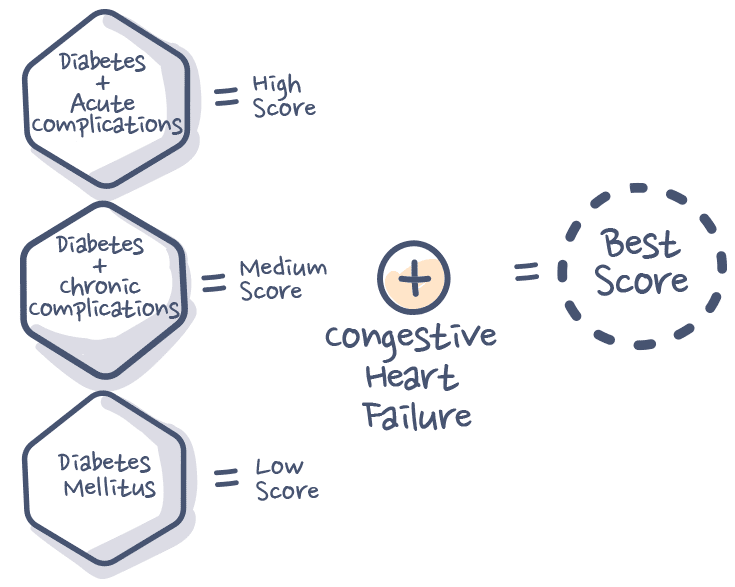Condition Counts
Origin
The 21st Century Cures Act passed in 2016 required CMS to make improvements to risk adjustment for 2019 and subsequent years. The changes were suggested to phase-in over a 3-year period and act as a new model through which risk adjustment is calculated. The proposed improvements for risk adjustment included adding additional diagnosis codes related to mental health and substance abuse, the inclusion of chronic kidney disease conditions, and what it means to consider the total number of conditions of an individual enrolled in Medicare Advantage (MA). Language in the bill specifically stated that in order to determine the appropriate adjustment for health status, the total number of diseases or conditions must be taken into account, often referred to as “condition counts”. Additional adjustments also can be made as the number of diseases or conditions increase.
Implementation
A year later, in December of 2017, the proposed implementation was published in the Advance Notice of Methodological Changes for Calendar Year (CY) 2019 for the Medicare Advantage (MA) CMS-HCC Risk Adjustment Model. The notice announced the proposed changes to the Part C Risk Adjustment Model for 2019 based on authority under section 1853(a)(1)(C) of the Social Security Act and echoed changes to the model that were required by the 21st Century Cures Act. The changes went into great detail about how they came up with the model that was proposed, known as the Payment Condition Count (PCC) Model.
The PCC Model interpreted the statutory requirement to “take into account the total number of diseases or conditions of an individual" to mean that in addition to the risk score that occurs within the payment model for each condition an individual has, the CMS-HCC risk adjustment Model should also account for the total number of conditions or diseases the beneficiary has.
Since the payment model is already additive and properly provides adjustment as the number of conditions increases, the requirement means that payment conditions must be taken into account for two different ways in CMS-HCC Models that have count variables. First, with a coefficient for the specific condition included in the model, then secondly with a coefficient for a variable that counts the total number of conditions or diseases the beneficiary has. The result being, when a condition count is inputted into the CMS-HCC Model, the projected expenses of each beneficiary would be the sum of demographic variables, specific conditions the beneficiary has that reside within the model (including co-morbidities), and the total condition count of the beneficiary.
The Advance Notice was open to public scrutiny, then in April of 2018 a final decision was published. There was industry pushback and little support for the PCC Model that had been proposed. Some industry stakeholders had feedback on Part I of the 2019 Advance Notice expressing that the proposed PCC Model did not meet the intended requirements of the Cures Act to improve prediction for the needs of beneficiaries with multiple chronic conditions. Requests to delay implementation and provide additional information of the proposed model ultimately brought forth a decision to update the HCC Model, but not to implement the PCC Model for 2019.
At the end of 2018 the next notice was published. The Advance Notice of Methodological Changes for Calendar Year (CY) 2020 for the Medicare Advantage (MA) CMS-HCC Risk Adjustment Model. The notice proposed an Alternative Payment Condition Count (APCC) Model designed to be more accurate and intended to be less prone to overpayment. This alternative model was proposed after industry feedback had suggested that the original payment condition count (PCC) model would not improve prediction in the CMS-HCC Model for high-need beneficiaries with multiple chronic conditions.
The APCC Model proposed a blended risk score calculation that consisted of 86 HCCs and included HCCs for Dementia (HCC51 & HCC52) and Pressure Ulcers (HCC159) as well as considering the number of conditions the beneficiary has.
In April of 2019, the final announcement was published and the APCC Model was implemented.
Condition Count Hierarchies
Hierarchies are applied prior to counting conditions, and contribute to how risk scores are calculated. If a beneficiary is coded with multiple conditions in the same hierarchy, then only the most severe manifestation of the condition is attributed to the risk score. The hierarchical structure is designed to absorb less complex conditions into more complex diagnoses. This is significant because it means that not every HCC disease is counted. Beneficiaries are credited for the category, then the hierarchy is taken into consideration. For example, if a patient is diagnosed with HCC19 Diabetes without complications and HCC18 Diabetes with Chronic Complications, they don’t get a condition count of two, they only get a count of one because HCC18 supersedes HCC19 in the hierarchy.
Now more than ever, accurate and evidence-based clinical documentation matters. The level of reimbursement and the healthcare resources available depends on the accuracy and specificity of documentation by physicians. Learn how you can capture every appropriate HCC code and get the reimbursements you deserve with A.I powered risk adjustment software from ForeSee Medical.



